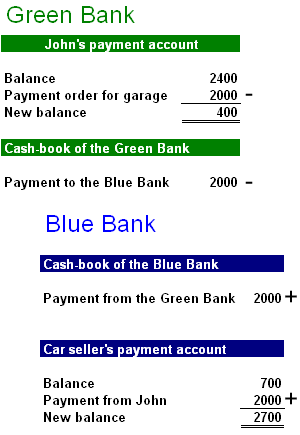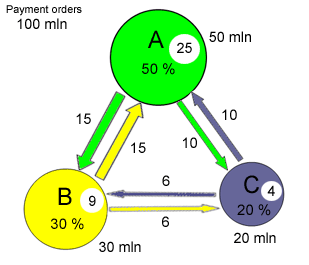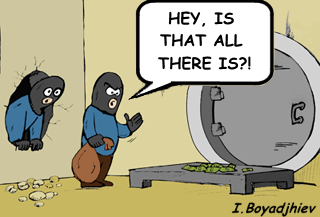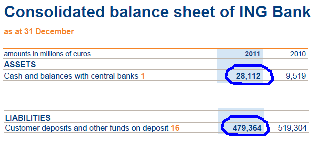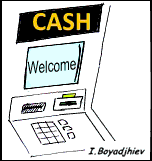The Magic of Bankers
SPOTLIGHT, CAPITALISM, ECONOMICS, 11 Feb 2019
Rudo de Ruijter | Court Fool – TRANSCEND Media Service
If you don’t know how banks work, you will never be able to understand the world.
Juggle money out of the hat. Of course, bankers cannot. But what they can is juggle numbers out of the hat and make everybody believe this is money.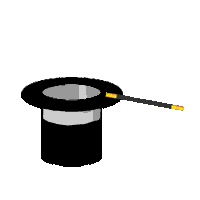 In a nutshell this is how bankers work. The trick is simple and we’ll unveil it in a moment. But unfortunately, it doesn’t stop there.
In a nutshell this is how bankers work. The trick is simple and we’ll unveil it in a moment. But unfortunately, it doesn’t stop there.
The little trick has tremendous consequences for our society. For when you are able to fool people that easily and when you also get well paid for that, you don’t want to stop. You can make people work for you, put politicians to your carriage and manage the whole society at will to put into circulation more and more of these profitable numbers. And as long as people don’t understand where there problems come from, the bankers can quietly continue to make us work for them. And each year a bit more.
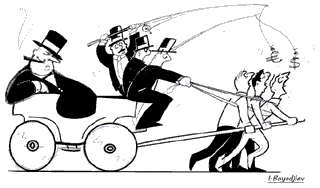 The characteristic of today’s banking system is the creation of balances for loans. This is done with a line of bookkeeping on the bank’s balance sheet, in which the debt of the borrower is written as an asset and a matching amount for the borrower as a liability. Put otherwise, the bank books the loan as a mutual debt acknowledgement. The borrower acknowledges he owes an amount to the bank (debit) and the bank acknowledges it owes a matching amount to the borrower (credit). The sheet stays balanced and the borrower now disposes of a bank balance. [1]
The characteristic of today’s banking system is the creation of balances for loans. This is done with a line of bookkeeping on the bank’s balance sheet, in which the debt of the borrower is written as an asset and a matching amount for the borrower as a liability. Put otherwise, the bank books the loan as a mutual debt acknowledgement. The borrower acknowledges he owes an amount to the bank (debit) and the bank acknowledges it owes a matching amount to the borrower (credit). The sheet stays balanced and the borrower now disposes of a bank balance. [1]
Buy a car?
Example: John wants to buy a car and borrows 2000 euro from the bank.
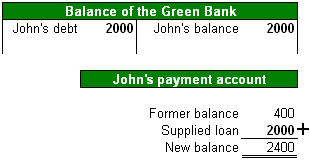 Now, John has still no money in his purse. [2] But he has a bank balance, with which he can order his bank to pay the car for him. He gives this order with his bank card.
Now, John has still no money in his purse. [2] But he has a bank balance, with which he can order his bank to pay the car for him. He gives this order with his bank card.
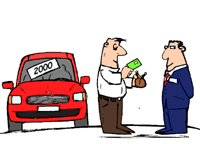 Most people will think, that if the banks owe us money, they have it. They take care of our payments, don’t they? Well, let’s have a closer look at that.
Most people will think, that if the banks owe us money, they have it. They take care of our payments, don’t they? Well, let’s have a closer look at that.
Payments via the bank
We can give the bank orders to execute payments for us with a bank card, check, pre-authorised payment, transfer formular or via internet banking. When the bank pays something for us, a part of our balance disappears.
Example: John’s payment order in favour of the car seller. John is with the Green Bank and the car seller with the Blue Bank.
When we order a payment in favour of someone with another bank, our bank has to transfer the money to that other bank. The benificiary does not receive any money, but, instead, he receives a new balance from his own bank.
In the example above the Green bank pays 2,000 euros to the Blue Bank. That is the way it goes in theory.
However, in the practice of the daily payments between banks, in average all incoming and outgoing payments cancel each other!!!
Example:
Suppose there are 3 banks in the country. Bank A services 50 percent of the population, Bank B 30 percent and Bank C 20 percent. Let’s say, on a day, all payment orders of the whole population together amounts to 100 million euros.
Then, in average, half of these orders (50 mln) come from customers of Bank A. They are in favour of customers of whom half are with Bank A itself (25 nln), while the rest has to be paid to Bank B (30/50 of the remaining 25 mln, which makes 15 mln) and Bank C (20/50 of 25 mln, which makes 10 mln.)
If we repeat these calculations for the payment orders from customers from Bank B and C, we see that – in average – all mutual payments between the banks cancel each other out.
At the end of the day, only the minor differences that occur in reality are effectively paid. Banks need very little money to execute all payment orders.
Note that banks supply new loans continuously, again in proportion to their size. The average payments that come forth out of the use of these loans, will also cancel each other out in the same way.
- Nearly empty vaults
Indeed, banks have very little money. For each euro they owe us, they have just a few cents. The rest of the money doesn’t exist. Neither in a vault somewhere, nor at the central bank. What we have in our bank accounts is almost completely thin air.
To establish this you don’t even have to have access to the vault. It is published in the annual report of the banks.
Here an extract of the annual report of ING of 2011. The cash of the bank, together with the balance they have at the central bank, amounts to 28 billion. The money the bank owes to customers amounts to 479 billion. So they don’t even dispose of 6 cents for each euro they owe them. In the right column you can see this proportion was even worse in 2010. Then they had in average 2 cents for each euro they owed to their customers.
The little bit of money banks have serves for the payments between banks as well as for handing out cash to customers who ask for it. And if some day the bank hasn’t enough cash, the customers simply have a run on bad luck.
A bank balance is an individual agreement between a bank and a customer. As long as the bank doesn’t fail, our balance, together with our cash money, determines how much we can purchase. In the economy the bank balances have largely taken over the function of money. (Most economists haven’t had a financial training and don’t make a difference between money and bank balances. They designate the amounts in our bank accounts as ‘money in circulation’.)
- Installments
When a borrower pays a part of his debt, both his debt and his bank balance decreases. This way the ‘borrowed’ amount progressively disappears again.
Summary
So far we have seen how bankers fool us with loans. We don’t borrow any money, but we receive a bank balance, or to say it otherwise, a recognition by the bank it still owes us the money. And although, in theory, we have the right to claim the money, our bank only has a tiny little percentage of what it owes to its customers. The rest of the money doesn’t exist.
When we order our bank to make a payment for us, a part of our balance disappears and the bank pays the amount to the bank of the favoured person. (At least in theory, in practice all payments between banks cancel each other for the greater part.) The beneficiary doesn’t receive the money. Instead, he receives a new balance of his own bank.
In The cancer of bankers you can read how this magic trick of the bankers ends up in a sickly growing mountain of debts with a permanently growing burden of interest, which, today, already demands 1/3 of our spendable income.
Sources and explanations:
- Banks don’t like to give openness about their working methods. This is probably because – ethically speaking – they are based on deception and swindle. People think they borrow money, but they are fooled with numbers from the hat. The method is explained in university books of the faculty of Finance, like in “Money, Financial Markets & Financial Institutions” by C. van Ewijk & L.J.R. Scholtens (Wolters Noordhoff, in Dutch). A bit more cryptically you can also read it in a pdf of the Bank of England: “Whenever a bank makes a loan, it simultaneously creates a matching deposit in the borrower’s bank account.”
http://www.courtfool.info/Bank_of_England_prereleasemoneycreation.pdf - In financial science bank balances are often called ‘near money’. With a bank balance you cannot pay. You can only order your bank to make a payment for you.
_________________________________________________
Rudo de Ruijter – Independent researcher Netherlands
You may freely copy and republish this article in newspapers, magazines, webpages, multimedia etc.
Go to Original – courtfool.ingo
DISCLAIMER: The statements, views and opinions expressed in pieces republished here are solely those of the authors and do not necessarily represent those of TMS. In accordance with title 17 U.S.C. section 107, this material is distributed without profit to those who have expressed a prior interest in receiving the included information for research and educational purposes. TMS has no affiliation whatsoever with the originator of this article nor is TMS endorsed or sponsored by the originator. “GO TO ORIGINAL” links are provided as a convenience to our readers and allow for verification of authenticity. However, as originating pages are often updated by their originating host sites, the versions posted may not match the versions our readers view when clicking the “GO TO ORIGINAL” links. This site contains copyrighted material the use of which has not always been specifically authorized by the copyright owner. We are making such material available in our efforts to advance understanding of environmental, political, human rights, economic, democracy, scientific, and social justice issues, etc. We believe this constitutes a ‘fair use’ of any such copyrighted material as provided for in section 107 of the US Copyright Law. In accordance with Title 17 U.S.C. Section 107, the material on this site is distributed without profit to those who have expressed a prior interest in receiving the included information for research and educational purposes. For more information go to: http://www.law.cornell.edu/uscode/17/107.shtml. If you wish to use copyrighted material from this site for purposes of your own that go beyond ‘fair use’, you must obtain permission from the copyright owner.
Read more
Click here to go to the current weekly digest or pick another article:
SPOTLIGHT:
- This Is How the U.S.-Run GHF Tried to Build a Local Network of ‘Aid Collaborators’ in Gaza
- Trigger-Happy States and the Death of Diplomacy
- How U.S. & Israel Used Rafael Grossi to Hijack the IAEA and Start a War on Iran
CAPITALISM:
- January 20, 2025
- The Dismal Pseudo-Science
- Trillions in Dirty Money: How Hidden Loopholes Fuel Corruption and Inequality
ECONOMICS:
- From Private Profit to Public Power: World’s Richest 1% Increased Wealth by $33.9 Trillion Since 2015
- Eradicating Poverty beyond Growth: Reforming the Global Financial Architecture for Ecological and Social Justice
- Two Hundred Years Ago, France Strangled the Haitian Revolution with an Inhumane Debt By Vijay Prashad
